A proposal for fractional coinage by Agustín de Coronas
by Pedro Damián Cano Borregobased on Pedro Damián Cano Borrego, “Los dibujos para el proyecto de moneda menuda de cobre en México en la representación de Agustín de Coronas”, in El Boletín Numismático, vol. XXXV, Núm. 272, July-September 2021
In the Archivo General de Indias (“AGI”) of the Secretaría de Estado y del Despacho de Hacienda, under the reference Ultramar, 837, and with the generic title of “Extinción de la moneda macuquina en América”, , there is, among other files, one relating to the withdrawal of the currency called tlaco (Expediente sobre la extinción en México de la moneda llamada tlaco). It consists of four hundred folios, consisting of (1) the Memorial of Agustín de Coronas of 1767, (2) the reports issued between the years 1768 and 1769 on the substitution of the tlacos by small coins, (3) the proposal of 1770 by Nicolás Vélez de Guevara Suescún on the introduction of the copper coin, (4) the viceroy's reports on the witndrawal of the tlacos in 1790, (5) a representation of the Guadalajara City Council between the years 1790 and 1801, and (6) a proclamation of the viceroy Calleja on the tlacos issued in 1814.
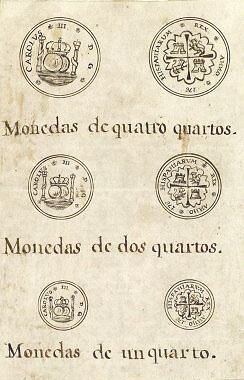
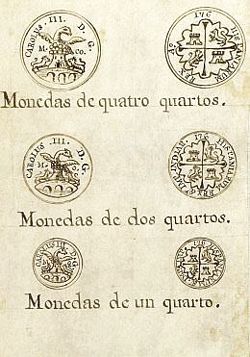
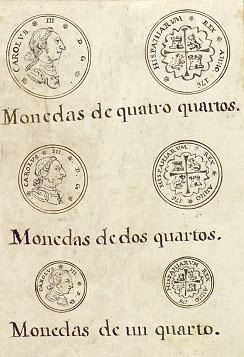
Proposals for designs for new coins, sewn into Coronas’ memorial
Concentrating on the study of the first of these, we find in the first place a very valuable graphic document classified by the AGI with the symbol MP-MONEDAS, 132, in which, annexed to the representation printed on 29 December 1766 by Agustín de Coronas y Paredes, who had relatives in the Holy Office of the Inquisition of Seville, and where the injuriousness of the use of these coins and the convenience of introducing copper coins from the Spanish peninsula into Mexico, as had already been done in other places, are outlined, we find a drawing of 40 coins of metal, copper or wood, used in the mestizo shops of the city of Mexico, with the text:
These are just a few of the many coins that the mestizo shops of Mexico City and other parts of the Kingdom have, one being of metal, others of copper, and some of wood, and each of them has the name or surname of who they are, each one being worth a clacoAgustín de Coronas always uses the term claco, unlike other documents in the file, which use the term tlaco , which is two quartos. four of them being half a real of silver.
Another very valuable document can be found under the reference MP-MONEDAS, 133. This is what we are going to focus our study on. It is a drawing of three projects for small copper coins in Mexico: cuartilla or cuatro cuartos, claco or two cuartos, and a half claco or a cuarto. This drawing is sewn into another representation printed in Madrid by Agustín de Coronas, dated 20 April 1771, in an annex to the representation of the same to Julián de Arriaga, with the reference México, 2816. In the same subject, unlike the previous one, he reported on the convenience of establishing a provincial copper coinage in New Spain, to avoid the damage of the coins of the peanut growers who had mestizo stores, since there was no small coin for the acquisition of small goods.
On 29 December 1766, Agustín de Coronas y Paredes presented a Memorial to the Crown informing that more than 2,000 merchants in Mexico City issued tokens for change, which were known as tlacos. Since the national silver half real was the smallest currency in circulation, the most disadvantaged layers of the population had to accept these tlacos in their daily purchases of lard. candles, bread, or other provisions. The tlacos were usually accepted only by their own issuer, so customers had to return to the same establishment in order to be able to redeem themFor this reason, Ruggiero Romano, in his Moneda, pseudomoneda y circulacion monetaria en las economía de México, Mexico City, 1998, p. 137, states that the circulation of the tlacos led to a kind of forced consumption.. The estimated number of these establishments was about two thousand. On many occasions consumers held these tlacos as a loss, and when the business ceased, which was apparently not uncommon, these coins were turned into scrap metal. In addition to the above, there were other abuses: If the user wanted to exchange the tlacos and pilons for silver coins, he had to pay a premium for it; likewise, its division, the pilón, with a value of 1/16 of a real, used to be demanded as compensation for purchases, so that in some popular markets in Mexico it is still common today that in commercial transactions the pilón is still required, replaced by a small portion of the merchandise purchased.
In his representation, Coronas highlighted the evils derived from the use of this unofficial means of exchange, requesting the issue of an official copper coin to replace it, taking as a reference the issues in Segovia of two cuartos in the years 1741 to 1743. His opinion was not shared by the Consulate of Merchants of Mexico City , which in a communication of 1768 maintained that Coronas exaggerated the instability of the mestizo stores and the pulperías José Enrique Covarrubias, La moneda de cobre en México, 1760-1842, un problema administrativo, Mexico City, 2000. On 24 October 1767, Carlos III ordered the Viceroy of New Spain to prohibit the use of tlacos and to proceed to collect all those that were in circulation[text needed], and a day later he gave instructions that the prior of the Consulate of the city, the superintendent of the mint, and the procurator general should be consulted on the advisability of minting vellón coins in New Spain.
The reasons alleged were refuted in the elaborate memorandum cited above, sent by the president and the consuls of the merchants' guild, stating that the issue of copper coin in the viceroyalty could harm the monarch himself, the merchants, the general public, the Indians, and the poor whites. For Juan Vicente de Güemes, viceroy of New Spain, the small coin had a greater influence on the internal trade of the kingdom, which could not exist without it; As there was no copper in these domains, it had been necessary for the shopkeepers to invent and forge, in their own way and from different materials, a certain class of coins, which were called tlacos, which they received in exchange for goods and also exchanged for money, although at an excessive profit. To remedy the abuses, an instruction had been formed for the minting of copper coins, and as the instructions were unclear, cuartillas had been minted, which provided relief to poor purchasersJuan Vicente de Guemes Pacheco de Padilla Horcasitas y Aguayo, Count of Revillagigedo, Instrucción reservada que el Conde de Revilla Gigedo dio a su successor en el mando Marqués de Branciforte,sobre el gobierno de este continente en el tiempo que fue su virrey, Mexico City, 1831, p. 114.
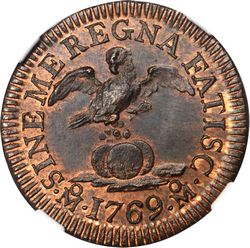
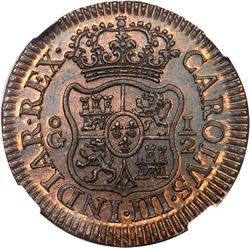
KM-PnC1 ½ grano 1769 Mo Go (Stack’s Bowers NYINC auction, January 2014, lot 1363)
During the reign of Charles III, three copper issues were minted in the Mexican Mint, despite the fact that the Crown had finally decided not to introduce the copper coin in Mexico, but to mint silver cuartos, so some authors argue that this issue was destined for the Philippines, a dependency of the Viceroyalty of New Spain. The first of these features a crowned monogram between REX and III with 1768 below on the obverse, and a large M between interlocking VE and 1/16 on the reverse. The other two are the grano and the half grano, the last a division of the peso of Tepuzque, weighing 0.0499 grams of silver and half of it respectively. On the obverse is a shield quartered and crowned between Gº 1, or 1/2, and the legend CAROLVS·III·INDIAR·REX; on the reverse an eagle over globes, and below the date between the initials of the mint, and the legend SINE ME REGNA FATISCVNT.
The 1768 Copper Issues at the Mexican Mint and the Coronas Project

4 maravedis Segovia 1743 (Aureo & Calicó, Auction 260, 27 May 2014, lot 56)
As we mentioned, the Coronas file has a drawing sewn with three different proposals for the issue of small currency in the Mexican mint. Earlier we have alluded to the fact that for this author the model to follow would be that of the two-cuartos issues of Segovia minted between the years 1741 and 1743. However, the designs used for the reverses of the three proposals, which are the same, do not correspond to those used in these issues, but are similar to those of the Spanish provincial pesetas minted in Madrid at that time.
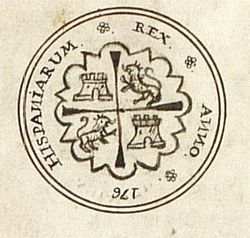
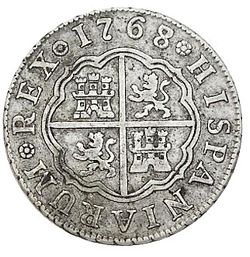
Reverse common to all proposals and reverse of 2 reales Madrid 1768/7, PJ.
In these, the coat of arms depicted is far from the one used contemporaneously in the issues of the overseas mints, since while on the pillar coin the shield represented has in its centre the escutcheon of the fleurs-de-lis of Borbón and pomegranate, and is of the chasuble or bullskin type, in the provincial reales and pesetas it is a simple shield counter-quartered with castles and lions inside a polylobed border without a crown.
As for the different obverses proposed, the one that appears first on the left reproduces exactly on its obverse the Pillar coin’s worlds and seas, although eliminating the legend VTRAQUE VNUM’Of these he made one’ (Letter of St. Paul to the Ephesians, 2:14), replacing it with the name of the reigning monarch, CAROLVS III D.G. It depicts two hemispheres attached under the a crown, situated between the pillars of Hercules, Abila, and Calpe, also crowned, with signs on which we find the inscriptions PLUS (left) and VLTRA (right), all of which are over ocean waves.
<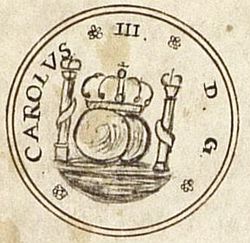
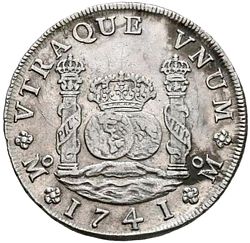
First proposal for the design of the four-quarter coin and reverse of a Mexican Pillar peso of 1741
In the second of the proposals, an eagle was reproduced on the heraldic coat of arms of Mexico City. The eagle, in the myth of Aztlán, is considered the symbol of the creation of Tenochtitlan, which with independence became the coat of arms of the nation and as such appear son monetary issues. The type used, however, replaces the city's coat of arms with orbs or hemispheres similar to those depicted on the Pillar coin described above. This type, as shown below, was already used in the Milanese issues of Charles I of Spain and V of Germany at the Milan mint in the mid-sixteenth century.
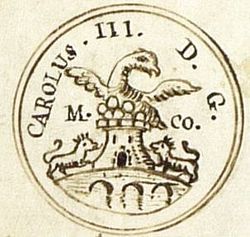
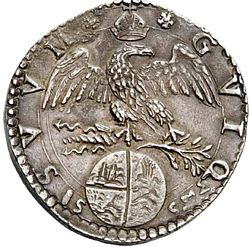
Second proposal for the design and reverse of 1/2 Milan coat of arms from 1552
In the third of the projects, the obverse reproduces the new design fixed by the Royal Pragmatics of 29 May 1771[text needed], which ordered the collection of all the previous silver circulation, and the engraving of a new coin with new types, with a bust of the Sovereign in the heroic style with a chlamys and laurel wreath. legend CAROLVS·III·DEI·GRATIA and the date on the obverse and the quartered coat of arms of Castile and León with an escutcheon of Anjou and a pointed pomegranate crowned on the reverse, flanked by the columns of Hercules with a sash and the legend PLUS ULTRA; and the legend HISPAN·EL·IND·REX and the mint mark, assayer mark and denomination on the reverse. The mints of Mexico, Guatemala, Lima, and Potosí began using these new designs in 1772.

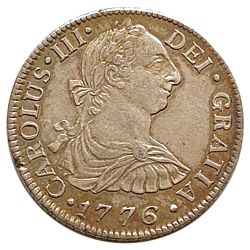
Third sketch and depiction of the obverse of a 1776 Mexican two-reales coin
It was not until the beginning of the nineteenth century that, with the vicissitudes of the liberation movements and on many occasions as an obsidional currency of necessity, copper issues began in different parts of America. According to SoriaVictor Manuel Soria Murillo, La Casa de Moneda de México bajo la administración borbónica, 1733-1821, Mexico City, 1994, p.222, these coins, nowadays very scarce in the numismatic market, were nothing more than samples ordered to be minted by the superintendent of the Mexican Mint; an experiment in which it was deduced that a marco of copper could produce coins with the extrinsic value of a ½ real of silver (deducting the amount of the material and the cost of working it), and its counterfeiting would not be profitable. What would be problematic would be its transportation, since seven reales in this copper coin would weigh the same as 108 reales in silver.
